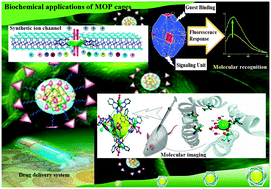Metal–organic molecular cages: applications of biochemical implications
Abstract
New well-designed materials are highly demanded with the prospect of versatile properties, offering successful applications as alternates to conventional materials. Major new insights into metal–organic self-assembled structures assisting biochemical purposes have recently emerged. Metal–organic polyhedral cages are highlighted as new research materials to be used for therapeutic, sensing and imaging, purposes etc. This tutorial review covers achievements in the biochemical applications of these multinuclear complexes. Examples of their ability to aid the ionic transport, biomolecular sensing, imaging, and drug delivery are presented.


 Please wait while we load your content...
Please wait while we load your content...